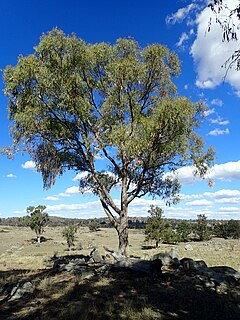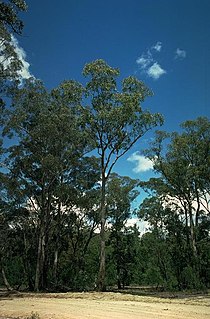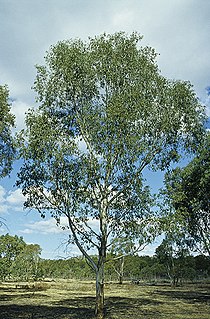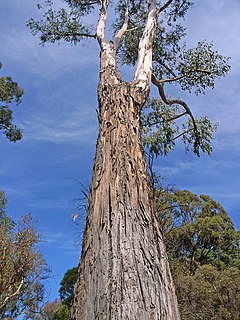
Eucalyptus delegatensis, commonly known as alpine ash, gum-topped stringybark, white-top and in Victoria as woollybutt, is a species of tree that is endemic to southeastern Australia. It has a straight trunk with rough, fibrous to stringy bark on the lower half of the trunk, smooth white bark above, lance-shaped to curved adult leaves, flower buds in groups of between seven and fifteen, white flowers and barrel-shaped or hemispherical fruit.

Eucalyptus polybractea, commonly known as the blue-leaved mallee or simply blue mallee, is a species of mallee that is endemic to south-eastern Australia. It has rough, fibrous or flaky bark on the lower part of the trunk, smooth greyish or brownish bark above, lance-shaped adult leaves, flower buds in groups of between seven and eleven, white flowers and cup-shaped or barrel-shaped fruit.

Eucalyptus nova-anglica, commonly known as the New England peppermint or black peppermint, is a species of small to medium-sized tree endemic to eastern Australia. It has thick, rough, fibrous bark on the trunk and larger branches, lance-shaped adult leaves, flower buds in groups of seven, white flowers and hemispherical or conical fruit.

Eucalyptus radiata, commonly known as the narrow-leaved peppermint or Forth River peppermint, is a species of tree that is endemic to south-eastern Australia. It has rough, fibrous to flaky bark on the trunk and larger branches, smooth grey bark on the thinner branches, lance-shaped to curved or almost linear leaves, flower buds in groups of eleven to twenty or more, white flowers and cup-shaped, hemispherical or shortenend spherical fruit.

Eucalyptus rubida, commonly known as candlebark, ribbon gum or white gum, is a species of small to medium-sized tree that is endemic to south-eastern Australia. It has smooth bark, sometimes with rough bark at the base, lance-shaped or curved adult leaves, flower buds in groups of three, white flowers and cup-shaped, hemispherical or bell-shaped fruit.

Eucalyptus viridis, commonly known as the green mallee, is a species of mallee or small tree that is endemic to south-eastern, continental Australia. It has rough fibrous or flaky bark on the lower trunk, smooth bark above, linear to narrow lance-shaped adult leaves, flower buds in groups of seven or nine, white flowers and cup-shaped fruit.

Eucalyptus fraxinoides, commonly known as the white ash or white mountain ash, is a medium-sized to tall tree of mountain country and is endemic to south eastern Australia. It has rough, compacted greyish bark on the lower trunk, smooth white bark with scribbles above, lance-shaped adult leaves, flower buds in groups of between seven and eleven, white flowers and barrel-shaped or urn-shaped fruit.

Eucalyptus quadrangulata, commonly known as the white-topped box or coast white box, is a species of small to medium-sized tree that is endemic to eastern Australia. It has rough, fibrous or flaky bark on the trunk and branches, lance-shaped to curved adult leaves, flower buds in groups of seven, white flowers and conical fruit.

Eucalyptus conica, commonly known as fuzzy box, is a species of tree endemic to eastern Australia. It has rough, flaky bark on the trunk and larger branches, smooth above, lance-shaped adult leaves, oval to diamond-shaped flower buds mostly arranged on a branching inflorescence on the ends of the branchlets, white flowers and conical fruit.

Eucalyptus angophoroides, commonly known as the apple-topped box, apple box or apple gum, is a tree endemic to south-eastern Australia. It has rough, flaky or fibrous bark on its trunk and larger branches, lance-shaped adult leaves, white flowers and conical to hemispherical fruit.

Eucalyptus kartzoffiana, commonly known as the Araluen gum, is a species of medium-sized tree that is endemic to a small area of southeastern New South Wales. It has rough, fibrous or flaky bark on part or most of its trunk, lance-shaped or curved adult leaves, flower buds in groups of three, white flowers and sessile, bell-shaped fruit.

Eucalyptus bridgesiana, commonly known as apple box, apple, apple gum or but-but, is a medium to large sized tree. It has rough, fibrous bark on the trunk and larger branches, smooth grey bark above, glossy green, lance-shaped adult leaves, flower buds in groups of seven, white flowers and hemispherical fruit.

Eucalyptus consideniana, commonly known as yertchuk, is a species of plant in the myrtle family and is endemic to south-eastern Australia. It is a tree with rough, fibrous, sometimes prickly bark on the trunk and larger branches, smooth grey bark above, lance-shaped or curved adult leaves, flower buds in groups of between eleven and nineteen, white flowers and conical to hemispherical fruit.

Eucalyptus chloroclada, commonly known as Baradine gum, red gum or dirty gum, is a species of small to medium-sized tree that is endemic to eastern Australia. It usually has fibrous to flaky bark on the trunk and smooth bark above, lance-shaped adult leaves, flower buds in groups of seven, white flowers and hemispherical fruit.

Eucalyptus andrewsii, commonly known as the New England blackbutt, is a tree native to New South Wales and Queensland in eastern Australia. It is a tree with rough bark on the trunk and larger branches, lance-shaped often curved leaves, flower buds in groups of between eleven and fifteen and hemispherical or cup-shaped fruit.

Eucalyptus banksii, commonly known as the Tenterfield woollybutt, is a tree that is endemic to eastern Australia. It has rough fibrous or flaky bark, lance-shaped to curved leaves, flower buds without a pedicel in groups of seven in leaf axils, white flowers and hemispherical to cup-shaped or conical fruit.

Eucalyptus dunnii, commonly known as Dunn's white gum or simply white gum, is a species of medium-sized to tall tree that is endemic to eastern Australia. It has rough bark near the base, smooth white to cream-coloured bark above, lance-shaped to curved adult leaves, flower buds in groups of seven, white flowers and cup-shaped, conical or hemispherical fruit.

Eucalyptus intertexta, commonly known as inland red box, western red box, gum coolibah or the bastard coolibah, is a species of tree that is endemic to central Australia. It has rough, fibrous or flaky bark on the base of the trunk, smooth white to brownish bark above, lance-shaped adult leaves, flower buds in groups of seven on the ends of branchlets, white flowers and cup-shaped to hemispherical fruit.

Eucalyptus morrisii, commonly known as grey mallee, is a species of mallee or straggly tree that is endemic to western New South Wales. It has rough, fibrous or flaky bark on some or all of the trunk, smooth greyish bark above, lance-shaped adult leaves, flower buds usually in groups of three, white flowers and conical or hemispherical fruit.

Eucalyptus rudderi, or Rudder's box, is a species of tree that is endemic to northern New South Wales. It has rough fibrous or flaky bark on the trunk and branches, lance-shaped adult leaves, flower buds in groups of seven, white flowers and barrel-shaped or hemispherical fruit.






















